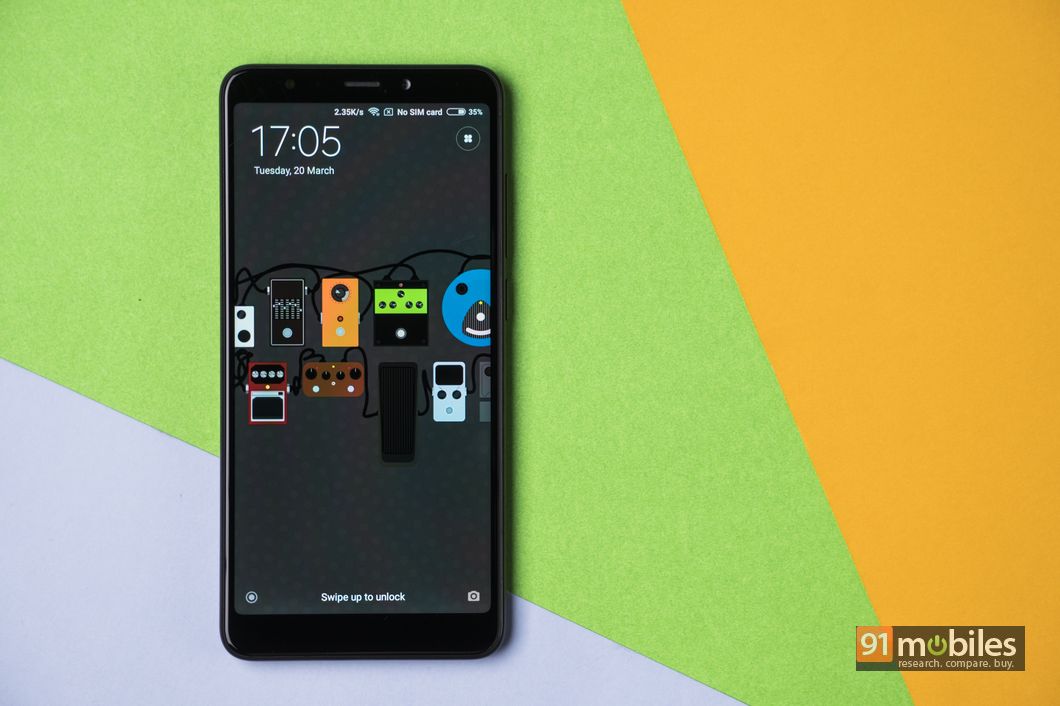“The Xiaomi Redmi 5 is the most affordable bezel-less smartphone to come out of the company’s stables”
It’s no secret that consumers looking for an affordable smartphone these days are spoilt for choice. Take offerings from the Chinese tech giant Xiaomi for instance. The company recently announced the Redmi Note 5 (review) and the Redmi Note 5 Pro (review), both of which were excellently received by consumers and critics alike. Now, less than a month later, the company has launched an even lower-priced smartphone in the form of the Redmi 5 (first impressions), which takes the brand’s tally up to three sub-Rs 15k smartphones in just the first quarter of 2018.
Now, we have already established that the Redmi Note 5 duo are excellent smartphones, but how good is the company’s latest offering, the Redmi 5? Should you buy it over the slightly more expensive Redmi Note 5? And how does it stack up against the competition? I intend on answering those questions and many others in this review. Stay with me.
Table of Contents
Specs at a glance
| Display | |
| Size | 5.7 Inch |
| Resolution | 720 x 1440 pixels |
| Performance | |
| CPU | Octa core, 1.8 GHz, Snapdragon 450 |
| RAM | 2 GB |
| Storage | |
| Internal memory | 16 GB |
| External memory | Up to 128 GB |
| Battery | |
| Capacity | 3300 mAH, Li-ion, Non removable |
| Standby Time | Up to 744 Hours (2G) |
| Camera | |
| Primary camera | 12 MP |
| Secondary camera | 5 MP |
| Connectivity | |
| Network support | Dual SIM 4G |
| Other options | Wi-Fi, Bluetooth 4.2, GPS |
| Others | |
| Battery Capacity | 3300 |
| Operating system | Android 7.1.2 Nougat |
Design
A trend which started with Xiaomi’s flagship smartphone, the Mi Mix, has now made its way over to the company’s budget offerings. You guessed it, I am talking about the Redmi 5’s bezel-less design which immediately gives the smartphone an edge over the competitor’s bezel-laden offerings. With that said, while Xiaomi has increased the screen-to-body ratio of the smartphone, the company has refrained from making any changes to the Redmi 5’s blueprint. In fact, from the back, you’d be hard-pressed to tell the difference between the Redmi Note 5, the Redmi 5 and the Redmi Note 4.
Be that as it may, the Redmi 5’s familiar design still feels solid and as far as the construction is concerned, the smartphone employs a mix of plastic and metal in its design. The frame of the smartphone has been constructed out of plastic, whereas the majority of the phone’s rear panel is metal, with the exception of two small sections on the top and the bottom which house the antenna bands. The smartphone feels really sleek and premium in the hand too, which is why I didn’t slap a case on my unit, even though the company bundles one with the retail packaging of the device. Moreover, thanks to its outstanding ergonomics and one-handed usability, I didn’t drop the Redmi 5 even once over the course of my review period.
Your primary means of interacting with the Xiaomi Redmi 5 will be via its 5.7-inch, 18:9 aspect ratio, HD+ display. Since it’s a 720p panel stretched across a 5.7-inch canvas, you will be able to see some pixels here and there. On the flip side, the display has decent viewing angles and gets adequately bright (and dim) under direct sunlight. Moreover, you also get the option of changing the colour temperature of the display from within the settings as per your taste. I preferred the tone of the display on my unit of the Redmi 5 from the get-go and therefore, didn’t tweak it further.
Even though the Redmi 5 is a budget offering, Xiaomi has included a fingerprint sensor for biometric authentication which can be found towards the back of the device. During my testing, the sensor worked flawlessly and unlocked the smartphone in a jiffy every time I placed my index finger on it.
Cameras
The cameras on the Xiaomi Redmi 5 are a bit of a sore point. In terms of specs, the handset features 12MP and 5MP sensors on the back and the front respectively. There’s a dedicated flash module present for both the camera sensors too, which helps with lowlight photography. Unfortunately, I wasn’t too impressed with the quality of the images shot from the Redmi 5. In situations with ample lighting, the smartphone manages to deliver decent quality pics with natural-looking colours. However, the smartphone takes a while to latch on to the subject and even then, the macro shots are often blurred. The low-light performance of the smartphone is nothing to write home about either, and the images I clicked with the device had substantial grain in them.
The smartphone’s front camera performance is average at best too. Selfies taken in a well-lit room had soft edges and were over-exposed. At night, despite using the dedicated selfie flash, most of the selfies I clicked still had significant noise in them.
Performance and Software
The Xiaomi Redmi 5 is powered by an octa-core Snapdragon 450 processor which works alongside either 2GB, 3GB or 4GB of RAM, depending upon which variant you opt for. Correspondingly, you’ll get either 16GB, 32GB or 64GB of built-in storage with the phone which can be further expanded by means of a microSD card. I had the 3GB / 32GB variant for review. As far as the performance is concerned, I was pleasantly surprised with the Snapdragon 450’s capabilities. Having previously reviewed the Redmi 5A which shipped with a Snapdragon 425 processor, I can confidently say that those upgrading to the Redmi 5 will observe a significant bump in the performance. Navigating through the UI was noticeably better on the Redmi 5, as was opening and closing applications. Moreover, my gaming sessions on the smartphone weren’t just limited to some PvP battles in Clash Royale and I could run more demanding titles like Unkilled too, albeit with slightly toned-down graphics settings.
Having said that, bear in mind that the Xiaomi Redmi 5 is a budget smartphone at the end of the day and therefore, you will notice a drop in speed if you push the smartphone too hard. Moreover, the smartphone struggles to keep applications in memory too and since the load times for certain applications is quite high, you will have to take a note of not opening certain apps together. For instance, during my usage, I made a mental note to not open Onefootball and Snapchat together, since both the are fairly resource-hungry applications. Another thing I’d like to point out is that while the smartphone managed to stay cool during day-to-day usage, the temperatures spiked to an uncomfortable number when the phone was put on charge.
Speaking of which, the Redmi 5 delivers excellent battery life, despite shipping with just a 3,300mAh cell. During my usage, I was easily able to get through the end of a day with heavy testing. Moreover, the smartphone recharges its battery fairly quickly.
The Redmi 5 runs MIUI v9 with Android Nougat as its base. My experience with the software on Xiaomi smartphones has been a bit of a rollercoaster ride. Initially, I wasn’t a fan of the custom platform, but Xiaomi has refined its UI quite a bit over the last year and the company keeps updating the OS with some nifty tweaks. This time around, it’s the presence of App Vault, an all-in-one aggregator which can be accessed by swiping left on the homescreen. Through App Vault, users will be able to view their calendar events, keep tabs on the latest cricket scores and even book cabs from Ola without having to install the application.
Other than that, the rest of the software features on the Redmi 5, including support for theming and running two instances of an app at the same time can be found on other smartphones by the company too.
Verdict
The Xiaomi Redmi 5 is a solid smartphone and for the price, gets a lot of things right. The handset offers stable performance, boasts an impressive battery life and is perfect for buyers who want a bezel-less smartphone which doesn’t break the bank. The smartphone starts at Rs 7,999 for the 2GB RAM model and the price goes up to Rs 8,999 and Rs 10,999 for the 3GB and 4GB RAM models respectively. And therein lies the problem. You see, instead of spending Rs 10,999 on the Redmi 5’s top-tier variant, one could instead just go for the Redmi Note 5 which is priced similarly, and ships with a faster processor, a better display, better battery life and much better cameras.

Furthermore, if you are willing to compromise on the Redmi 5’s bezel-less design, then you can pick up the Redmi Y1 (review) instead, which ships with a significantly better selfie camera and is more or less the same in terms of core performance. The Infinix Hot S3 (review) is another solid option to consider, thanks to its bezel-less display, 20MP front camera and 4,000mAh battery. All in all, while I do feel that the Redmi 5 brings a lot of nifty features to the table, the smartphone is eclipsed by its own siblings.
Editor’s rating: 3.5 / 5
Pros:
- Solid bezel-less design
- Good performer
- Good battery life
Cons:
- Low-res display
- Sub-par cameras
 Xiaomi Redmi 5 Xiaomi Redmi 5 | vs |  Xiaomi Redmi Note 5 Xiaomi Redmi Note 5 |
 Xiaomi Redmi 5 Xiaomi Redmi 5 | vs |  Xiaomi Redmi Y1 Xiaomi Redmi Y1 |




































